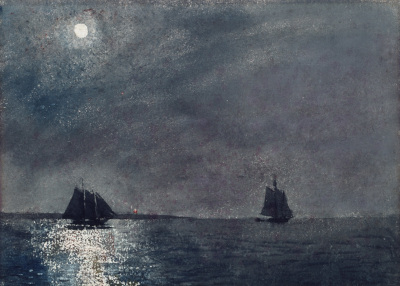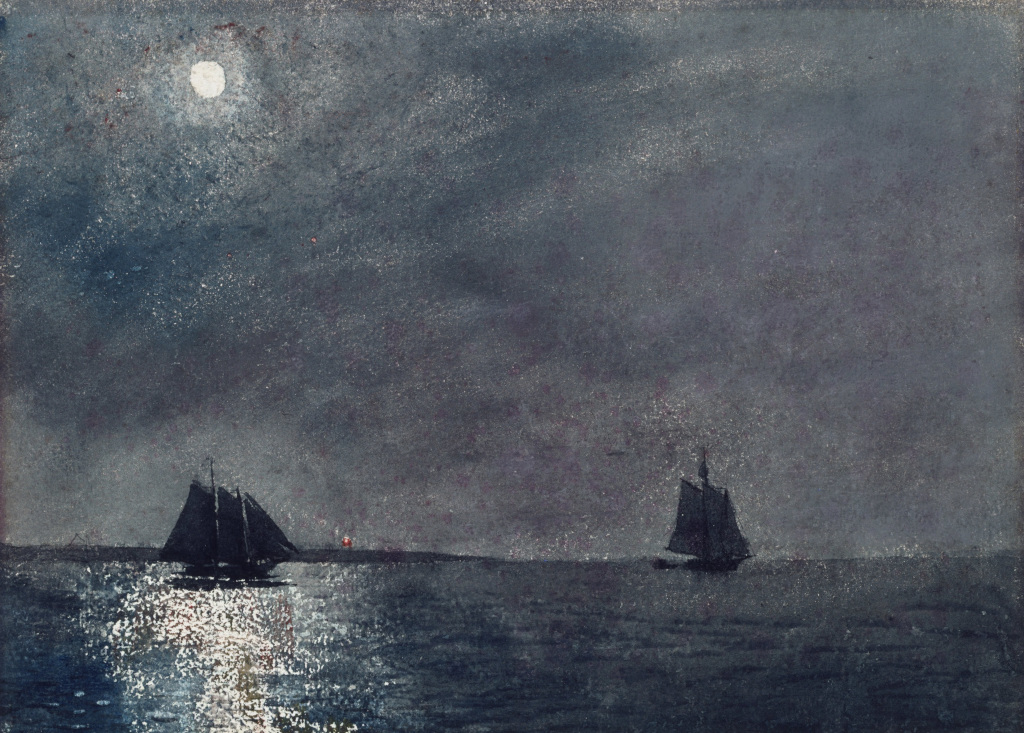Eastern Point Light is a famous location in Massachusetts, USA, which has inspired a number of paintings by American artists. The item in front of us here was completed in 1880 by Winslow Homer, who himself is best known for his seascape artworks.
The composition features two tall ships heading across an open expanse of water, with a bright light coming from the top left corner of the painting. Some of this light then reflects vertically across the left side of the work, bringing brightness to an otherwise darkened piece. The ships are delivered as silhouettes, though their outlines are detailed enough that we can determine much about their identity. The artwork itself remains in the collection of the Princeton University Art Museum and there was another related artwork by Winslow Homer which was titled, Eastern Point. The light itself was first opened in 1616 and is based on Cape Ann though is not believed to be open to the public currently. This particular piece was constructed using watercolour over graphite and there is a strong confidence in its dating of 1880, because of the travels of the artist that were documented at around that time. The watercolour itself is sized at 24.6 x 34.1 cm and the paper may well have been from a large watercolour pad which Homer could carry around on his person.
The artist worked from Ten Pound Island, off Gloucester, Massachusetts to produce a series of paintings in 1880, one of which was Eastern Point Light. Having already been sold on the seascape genre, the artist sought solace in this location and worked prolifically for several months across the summer. He could almost entirely remove humanity from this series and focus on the emotion and romance of the natural surroundings. He would later spend time in England where he continued to focus on seascapes and by that point could be considered to have entirely mastered the genre. Over time he would seek out new variations to the theme, such as with shipwrecks, or in how he travelled elsewhere to the likes of the Caribbean, where natural variations in content would occur. His work in this series from Ten Pound Island is considered to have been amongst his most expressive, where we almost see into the abstract world of the 20th century, with details kept to a minimum.
The reduction in tone variety here is highly interesting. Some might even see comparisons with the likes of Whistler, where a dimly lit piece carefully varies tones in a subtle manner. With the piece having been produced using watercolours, it is likely that Homer finished this painting pretty quickly. One can connect with his feelings for this location wit the expressive nature of his work here and he does not concern himself too much with the sort of precise detail that we can find elsewhere in his career. Homer's role in American art history makes his inclusion at the Princeton University Art Museum a highly valued one, and this particular piece is a good example of the genre in which he is best known. Some have also seen the influence of historic artists within this painting, in how the seascape is delivered and the small nature of the ships which drift along in the background.





